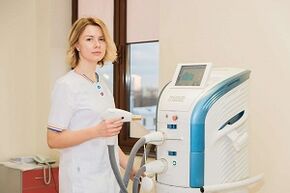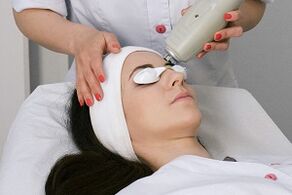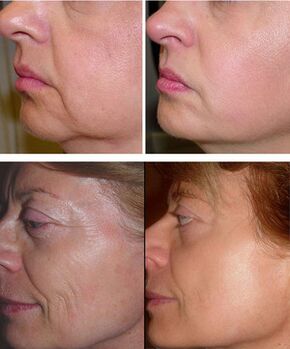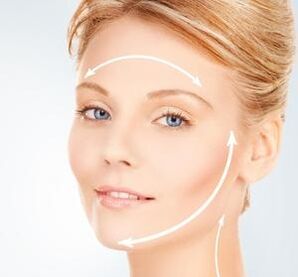
The skin of the face inevitably undergoes a natural aging process, which can be resisted by modern cosmetics and cosmetic procedures.
One of these procedures is laser rejuvenation of the face - thanks to the technique, the mechanisms of rejuvenation and cell regeneration are activated, the facial skin acquires a youthful, fresh and well-groomed appearance.
In cosmetology, a special laser is used to eliminate various skin problems. Fractional skin rejuvenation is very popular - a cosmetological procedure, after which you can increase the elasticity of the skin, eliminate fine and deep wrinkles and strengthen the oval of the face. After completing a session course, you will look a few years younger.
The essence and effect of technology

Laser skin rejuvenation is a technique in which laser radiation affects the skin. To do this, the laser source - a laser device - uses a device that can adjust the depth of penetration of the laser beam into the skin, the duration of exposure and the temperature of the radiation.
The correct choice of procedure parameters is the most important condition for successful rejuvenation, because the slightest mistake of a cosmetologist can cause facial burns.
The laser beam penetrates the tissue and causes slight damage to the cells, in response to the irritation that occurs, the cells begin to actively produce collagen and elastin, and the growth of new cells resumes.
Stimulation of the renewal process leads to a complete renewal and rejuvenation of the skin. The second name of the procedure is laser peeling.
Indications and contraindications
The technique is used to eliminate such age-related changes in the facial skin:
- Wrinkles
- Black spots.
- Flabbiness and sagging.
The indications for the procedure are as follows:
- Scars on the face.
- Acne scars.
- Unwanted tattoos.
- Keratinization of the skin.
- Enlarged pores.
- Facial vascular mesh.
- Stretches in the abdomen and legs after pregnancy.
Contraindications to laser peeling:
- Keloid scars.
- Malignant neoplasms.
- Pregnancy, lactation.
- Herpetic infection during an exacerbation.
- Facial wounds and abrasions.
- Any skin disease.
- Fresh tan.
- Moles.
- Take medication to treat acne.
In most cases, laser rejuvenation occurs without complications, and in the first days after the procedure, the patient notices a slight swelling, redness and peeling of the epidermis. These phenomena are normal for laser peeling and disappear spontaneously after a few days.
Possible side effects

However, in some cases, the following side effects may develop:
- Persistent facial redness.
- Inflammation of acne.
- Increased oiliness of the skin.
- Appearance of hyper or hypopigmentation.
- Herpetic eruptions (if the patient has previously been diagnosed with herpes).
- Burns.
- Maintaining the boundary between treated and untreated skin areas.
- Subcutaneous bleeding.
These side effects disappear for a long time and require additional treatment by a cosmetologist.
Advantages and disadvantages of peeling
Fractional shells are widely used due to the following advantages:
- High efficiency, the ability to eliminate significant aesthetic defects.
- Possibility of application on any skin type.
- Minimal risk of side effects (burns and hyperpigmentation).
- Painless.
- Short-term skin regeneration
- Ability to treat large areas of skin at once.
The disadvantage of fractional peeling is the high cost compared to other methods, but given the effectiveness of the procedure, this disadvantage can be considered insignificant.
Types of laser rejuvenation
There are several types of laser rejuvenation, depending on the depth of the laser penetration:

- Laser coating. . . The laser "works" on the surface layer of the epidermis, exfoliating dead cells. The result of the procedure is noticeable after a week: the skin becomes velvety to the touch, fine wrinkles disappear. Three types of laser beams are used during the procedure: erbium, carbon or neodymium.
- Laser biorevitalization. . . Radiation penetrates deep into the skin, destroying some cells. The technique is more rigid than laser coating, but has a strong anti-aging effect. To enhance the effect of the laser, the cosmetologist applies a mixture of nutrients to the skin. After the procedure, deep wrinkles disappear and facial contours improve. Recovery after biorevitalization occurs within three months, during which time the edema and severe peeling of the epidermis on the face may continue.
- Fractional peeling. . . Fractional laser rejuvenation is the most effective and at the same time subtle method. The peculiarity of the procedure is that the laser beam is divided into many micro-beams, so it has a softer effect on the skin. Radiation strikes the skin in the form of a mesh, so whole areas remain between the foci of cell damage - this helps in faster tissue regeneration and a stronger rejuvenating effect. During fractional peeling, the intensity of the beam can be changed using a carbon dioxide or erbium laser.
Stages of the procedure
You should see a cosmetologist before performing the procedure. The doctor identifies the existing problems, asks the patient if there are any contraindications to the procedure, talks about how laser rejuvenation will occur.
If the patient's skin is prone to increased pigmentation, a whitening cream is prescribed a few days before the rejuvenation session. The patient should know that before the procedure, do not engage in sports, heavy physical labor or alcohol.
Fractional peeling sequence:
- The face is cleansed with ordinary cosmetics.
- An anesthetic cream is applied to your skin.
- After a few minutes, the anesthesia is washed off and a gel is applied to facilitate the sliding of the fraction head. The glasses are placed in the patient's eyes.
- The doctor moves the nozzle over the face, sequentially affecting each area with a laser.
- The treatment lasts 15-60 minutes, after which a soothing cream is applied to the skin.
In general, you should go through 3-4 procedures, the interval between them is 1-2 months.
Skin care at home

After laser treatment, swelling, redness, peeling and itching appear on the skin, followed by the formation of crusts. Patients should follow these recommendations:
- Apply a cold compress to your face to eliminate puffiness.
- Apply anti-inflammatory and soothing creams on your skin (prescribed by a cosmetologist).
- Apply sunscreen on your face before going out.
- Do not go to the bath, sauna or hot tub for two weeks after the procedure.
- Do not use scrubs; Apply cosmetics only with the permission of a cosmetologist.
- To prevent scars on the face, do not remove the peeling.
If the laser rejuvenation is performed by a highly qualified specialist and the patient follows all the recommendations of the doctor, the result of the procedure has an excellent cosmetic effect.














































































